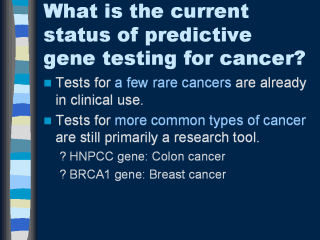|
|
|
|
front |1 |2 |3 |4 |5 |6 |7 |8 |9 |10 |11 |12 |13 |14 |15 |16 |17 |18 |19 |20 |21 |22 |23 |24 |25 |26 |27 |28 |29 |30 |31 |32 |33 |34 |35 |36 |37 |38 |39 |40 |Glossary |review |
 |
Tests for a few rare cancers are already in clinical use. Predictive gene tests
for more common types of cancer are still primarily a research tool, difficult
to execute and available only through research programs to small numbers of
people who have a strong family history of disease. But the field of gene
testing is evolving rapidly, with new genes being discovered almost daily and
innovations in testing arriving almost as quickly. For example: Predictive tests already are being used routinely in selected families with retinoblastoma and Wilms' tumor. A gene test is available for persons in the rare cancer-prone Li-Fraumeni families. However, it is available only to participants in a research study, and experts caution that it must be offered with great care, weighing benefits against risks. A test is in place for the gene that triggers familial adenomatous polyposis, a tendency to form hundreds of colon polyps, some of which, if not removed, will go on to become cancerous. (But the condition can also be diagnosed without the gene test.) A set of genes that predispose a person to a much more common type of colon cancer (hereditary nonpolyposis colon cancer, or HNPCC) has been identified in high-risk families. These genetic alterations are thought to be carried by as many as 1 million Americans, and to cause about 90 percent of all inherited colon cancers, or about 15 percent of the 160,000 colon cancers diagnosed in the United States each year. The genes have also been linked to cancers of the uterus, stomach, ovary, small intestine, gall bladder, kidney, and ureter. Very high-risk families (three or more affected members, at least one before age 50, over two or more generations) are being tested at a few research centers. A blood test is expected in a year or two. The BRCA1 gene mutation predisposes a person to hereditary breast cancer and ovarian cancer. A mutant BRCA1 gene on chromosome 17 is probably responsible for about 5 percent of the 182,000 cases of breast cancer predicted for a single year, and as many as a quarter of the cases occurring in women ages 45 and younger. A mutant BRCA1 gene is found in nearly half of the families with a high incidence of breast cancer and in at least 80 percent of the families with a history of both early onset breast and ovarian cancer. With the isolation of the gene, a blood test is expected, but before it becomes available, research studies must address important questions about optimum management of BRCA1 mutation carriers. (On chromosome 13, scientists have also found evidence of a second breast cancer gene called BRCA2.) Genes have been reported for melanoma, leukemia, thyroid and renal cell cancer, and scientists are closing in on genes for several other cancers. |